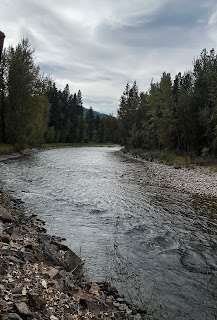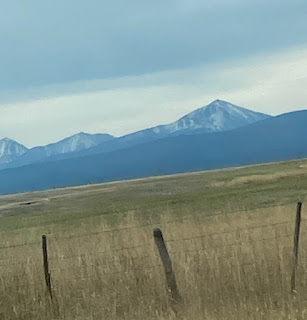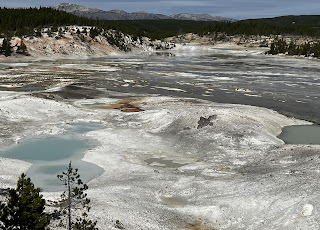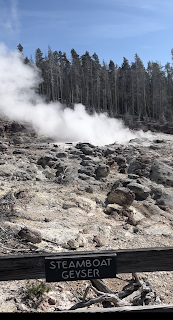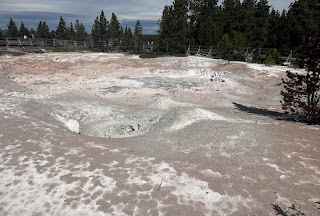Review: Supernatural
Tales, by Vernon Lee
by Rich Horton
Vernon Lee was the name used by Violet Paget
(1856-1935), an English writer who lived her entire life on the continent --
born in France to English parents, she eventually settled in Italy. Her primary
interest was esthetics, and she wrote extensively on the subject, influenced by
Walter Pater and then by her lover, Clementina Anstruther-Thomson. She also
wrote on travel, a couple of novels, and a great many supernatural stories. She
was very prominent in intellectual circles in her life, and was friends with
the likes of Edith Wharton, Henry James, and her exact contemporary John Singer
Sargent (who was a very close childhood friend, and who much later painted her
portrait.)
While Lee's intimate relationships were always with
women, and were quite "open", she refused the term Lesbian, and given
that she used the name "Vernon Lee" not just as a pseudonym, but in
her personal life as well, it is tempting to wonder if in contemporary terms,
she might have identified as a trans man, though who can say? Her most
controversial view, in her day, was her very passionate pacifism, which formed
the thematic basis for her 1921 novel Satan
the Waster. These views were very unpopular in her time, and seem to have
contributed to her declining reputation late in her life. I recently wrote
about Rose Macaulay, who was likewise a fierce pacifist during the first War,
and who changed her views with the rise of Hitler. It’s interesting to wonder
if Lee might also have moderated her views had she lived longer.

It is her supernatural stories that are best known in
the present day, and after some long period of relative neglect, I sense that
in the past few decades her work has achieved a significant reputation among
aficionados of "weird fiction". The book at hand was assembled in
1955 by her executrix, Irene Cooper Willis, collecting six of her better known
Supernatural Tales. Willis also
contributes an introduction, discussing Lee in quite personal terms (they were close
friend from 1911 until Lee’s death) and also including some words from Lee
herself about a few of the pieces. My edition is a 1987 reprint.
I'll briefly consider each story:
“Prince Alberic and the Snake Lady” (18,000 words, originally
in the July 1896 issue of The Yellow Book,
collected in Pope Jacynth, 1904)
This is one of Lee’s most famous stories, and it was
published in one of the most central (and controversial) periodicals of the
1890s. The Yellow Book may be best
known for the illustrations by Aubrey Beardsley, John Singer Sargent, Walter Sickert
and others; but the literary contents were also significant – they published
the likes of Max Beerbohm, H. G. Wells, Henry James, and W. B. Yeats. They were
famous for a highly esthetic approach (surely much in sympathy with Vernon
Lee’s views) and for an attitude of decadence.
Prince Alberic is the grandson and heir of Duke
Balthasar. The Duke is a vain and arbitrary man, and when he redecorates his
Red Palace, he notices for the first time that Alberic’s chambers are hung with
an old-fashioned tapestry, and he replaces it with a new one. But the boy had
loved the older tapestry, which showed his ancestor, also named Alberic, and
the half-snake/half-woman Oriana. Young Alberic destroys the new tapestry, and
the Duke, in fury, exiles him to a remote estate. This backfires, however, for
Alberic had hated the Red Palace, and became much happier in the new place,
especially after he made a pet of a grass snake, and also met an older woman
who visited him for an hour each day and instructed him.
It’s easy enough to see where this is going, though
the story rather takes its time getting there. The Duke’s rage at his heir’s
behavior increases, and the Duke’s three chief counsellors, who each hate the
others, begin to compete to either be in position to take credit for Alberic’s
death if the Duke so desires, or to be in the boy’s favor if things to in a
different direction. But mysteriously, all their efforts are trumped by another
influence. Eventually, financial pressures force the Duke to try to find an
advantageous marriage for his heir – but by this time, Alberic, now a young
man, has no interest in other women – for, of course, he has fallen in love
with Oriana. There is a back story for the Snake Lady, and a dark resolution
for everyone. It’s a fine story, though I felt it might have been a bit better
if a bit shorter, and I also found the prose a touch too fussy – which is not
the case for the other stories collected here. All that said, on reflection the
story still seems to me quite powerful – perhaps it deserves a reread.
“A Wedding Chest” (4200 words, from Pope Jacynth, 1902)
This is a short and very dark story, rather nicely
structured. It opens with a description of a 15th century front
panel painting on the subject of “The Triumph of Love”, used for a wedding
chest, and continues to describe the circumstances of its painting. The chest
was for the wedding of a powerful man, Messer Troilo. The painter, Desiderio,
had refused to use the beautiful Maddalena as a model, for she was to be his
wife – which incensed Troilo, who already had his eye on her … and who
proceeded to kidnap and rape her. The end result is very dark – it’s a striking
story, a conte cruel, in my opinion
one of the best in the book, though there is no real supernatural element. I
was reminded of the incident that drives the plot of Alessandro Manzoni’s The Betrothed (a novel Lee certainly
must have known), and there is also a reference to the plague, though I’m not
sure the same plague that features in Manzoni’s novel is intended.
“Amour Dure” (14000 words, from Hauntings, 1890)
My favorite of these six stories. It’s presented as
extracts from the diary of Spiridon Trepka, a young Polish professor working in
the Archives of a small Italian town, Urbania. He is interested in the history
of the town, but distracted by the modern day annoyances of life there. But he
becomes obsessed with the story of Medea di Carpi, a young woman born in 1556,
with a somewhat legendary scandalous history, in that her various husbands and
lovers all ended up murdered, either by her or some other mischance. And as
Spiridon learns more, he begins to receive strange letters, on ancient paper,
urging him to visit a certain decrepit church … and soon he is convinced that
it is Medea herself, begging him to free her from her ghostly existence. His
fate is easily guessed! But the story gets to that end very effectively.
“A Wicked Voice” (11,000 words, from Hauntings, 1890)
This story concerns a late 19th century composer,
a devotee of Wagner, who has nothing but contempt for the music of the 18th
century, and especially for the singers of that time. His project is an opera
based on Ogier the Dane, but he ends up, to his disgust, an expert on an 18th
century singer named Zaffarini, and on a legend concerning this man, who
apparently could sing so beautifully that he could make any woman fall in love
with him, and then kill her with his song. Inevitably, the composer begins to
hear a mysterious singing voice, and the voice overwhelms his inspirations for
his opera, completely taking over his true ambitions.
“The Legend of Madame Krasinska” (10,500 words, from Vanitas, 1892)
Another favorite of mine. Madame Krasinska is an
American woman, still quite young though a widow (she had married a wealthy
Polish man.) She is an idle woman, given only to frivolous amusements, not even
to love affairs. And then, for a costume ball, she decides to go as Sora Lena,
a mad old woman well known around town, who constantly visits the train
station, waiting for her sons to return from the war – alas, they had been
killed in the war decades ago. Madame Krasinska’s cruel impersonation is a hit
– but soon after Sora Lena commits suicide. And then Madame Krasinska becomes
increasingly unhappy, and feels more and more that she is a different person –
she begins wandering to the train station, and starts to think her real
apartments are somewhere else. The climax, in the abandoned room where Sora
Lena had lived, is beautifully done, with an effective surprise. There is a bit
more of a moral here than with many of these stories.
“The Virgin of the Seven Daggers” (11000 words, from For Maurice, 1927)
The only one of these tales not set in Italy, this
story begins in Grenada, with a depiction of the Church of Our Lady of the Seven
Daggers (including criticism of the architecture.) Then we go back to the late
17th century, during the reign of Charles II, “the Melancholy”. Don
Juan Guzman del Pulgar is introduced as a man of extreme wickedness, in many
ways but particularly in his treatment of women, in particular his seduction
and/or rape of seven beautiful women, including, most scandalous, a nun. Now he
has become obsessed with the legend of a surpassing beautiful Moorish Princess,
buried alive by her father as the Moors retreated from Spain, and supposedly
kept alive by magical means. He begs forgiveness from his patroness, the Virgin
of the Seven Daggers, for all his previous sins and for whatever sins he might commit
in his effort to penetrate to this Princess’s tomb, and claim her for his latest
mistress. This leads to a dangerous descent into the depths, where her tomb
lies, and his battle to reach the tomb, in which he commits further atrocities.
Only to reach the Princess, and wake her – and have her demand of him one thing
… the conclusion is logical and queerly moving in the context of the story.
This is truly a very fine collection of stories,
effectively “supernatural” in a very 19th century manner. I will be
making an effort to hunt down some more examples of Vernon Lee’s fiction.





